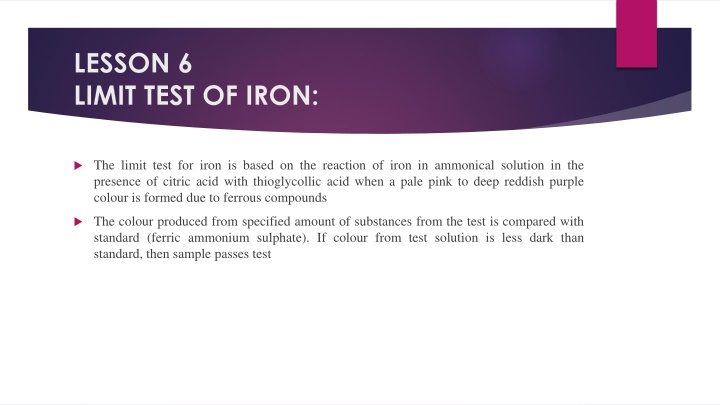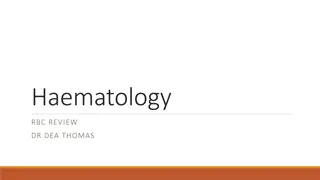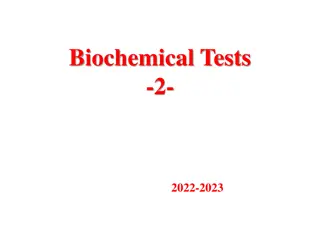Limit Test of Iron Based on Color Reaction with Thioglycollic Acid
The limit test for iron involves the reaction of iron in ammoniacal solution with citric acid and thioglycollic acid to form a reddish-purple color. By comparing the color produced with a standard solution, the presence of iron is determined. Citric acid prevents precipitation of iron, while thioglycollic acid acts as a reducing agent. The process includes preparing a standard solution of iron and conducting the test using specified steps to evaluate the color change.
Download Presentation

Please find below an Image/Link to download the presentation.
The content on the website is provided AS IS for your information and personal use only. It may not be sold, licensed, or shared on other websites without obtaining consent from the author.If you encounter any issues during the download, it is possible that the publisher has removed the file from their server.
You are allowed to download the files provided on this website for personal or commercial use, subject to the condition that they are used lawfully. All files are the property of their respective owners.
The content on the website is provided AS IS for your information and personal use only. It may not be sold, licensed, or shared on other websites without obtaining consent from the author.
E N D
Presentation Transcript
LESSON 6 LIMIT TEST OF IRON: The limit test for iron is based on the reaction of iron in ammonical solution in the presence of citric acid with thioglycollic acid when a pale pink to deep reddish purple colour is formed due to ferrous compounds The colour produced from specified amount of substances from the test is compared with standard (ferric ammonium sulphate). If colour from test solution is less dark than standard, then sample passes test
NOTE: Citric acid - It does not allow precipitation of iron as Fe(OH)3 by ammonia ,by forming complex with it and also with other metal cations Thioglycollic acid is useful analogue of glycolic acid CH2(OH)COOH which is prepared by the action of KSH on mono chloro acetic acid (CH2ClCOOH) CH2Cl.COOH + KSH CH2(SH)COOH +KCl Thioglycollic acid converts Fe3+ to Fe2+ and act as reducing agent.It gets complex with Fe2+ and gives ferrous thioglycolate. Ammonia is used to develop colour of the complex and ferrous thioglycolate gives pink to purple colour in alkaline medium so ammonia is used.
PROCEDURE: PREPARATION OF STANDARD SOLUTION OF IRON 0.173gms of ferric ammonium sulphate [ NH4Fe(SO4)2.12H20] was taken .To it 1.5ml HCl was added and made up to 1000ml with distilled water. Each ml of the solution contain 0.02mg iron
S.No TEST STANDARD 1 1g of NaCl sample was taken and dissolved in 40 ml of water in nessler s cylinder A 2ml of standard solution equal to 0.04mg Fe was taken and dissolved in 40ml of water in a nessler s cylinder B 2 To it, 2ml of 20%w/w citric acid ( ironfree) was added To it, 2ml of 20%w/w citric acid ( ironfree) was added 3 2 drops of thioglycolic acid added 2 drops of thioglycolic acid added 4 Solution was mixed well and made alkaline with ammonia Solution was mixed well and made alkaline with ammonia 5 Diluted to 50 ml with water Diluted to 50 ml with water 6 Stirred with glass rod and stand for 5min Stirred with glass rod and stand for 5min 7 Compared for the colour change Compared for the colour change
If the colour produced by test solution has been less than that of the standard, then sample passes the test























